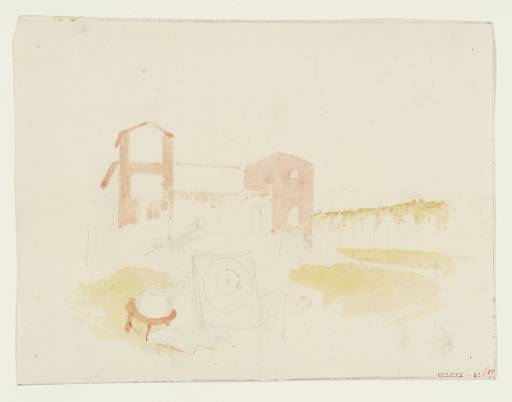Joseph Mallord William Turner Study for 'Galileo's Villa', Rogers's 'Italy' c.1826-7
Joseph Mallord William Turner,
Study for 'Galileo's Villa', Rogers's 'Italy'
c.1826-7
Joseph Mallord William Turner 1775–1851
Study for ‘Galileo’s Villa’, Rogers’s ‘Italy’ circa 1826–7
D27604
Turner Bequest CCLXXX 87
Turner Bequest CCLXXX 87
Pencil and watercolour, approximately 105 x 165 mm on white wove paper, 151 x 196 mm
Inscribed in red ink ‘(87’ bottom right
Stamped in black ‘CCLXXX 87’ bottom right
Inscribed in red ink ‘(87’ bottom right
Stamped in black ‘CCLXXX 87’ bottom right
Accepted by the nation as part of the Turner Bequest 1856
Exhibition history
1878
[Oxford Loan Collection], University of Oxford, 1878–1916 (129 and 97a).
1998
Turner and the Scientists, Tate Gallery, London, March–June 1998 (51, reproduced).
References
1878
Catalogue of Sketches by Turner Lent by The Trustees of the National Gallery to the Ruskin Drawing School, Oxford, London 1878, nos.129 (1st edition), 97a (2nd edition), as ‘Galileo’s Villa’.
1903
E.T. Cook and Alexander Wedderburn (eds.), Library Edition: The Works of John Ruskin: Volume I: Early Prose Writings 1834–1843, London 1903, pp.233, 244.
1904
E.T. Cook and Alexander Wedderburn (eds.), Library Edition: The Works of John Ruskin: Volume XIII: Turner: The Harbours of England; Catalogues and Notes, London 1904, pp.380–1.
1906
E.T. Cook and Alexander Wedderburn (eds.), Library Edition: The Works of John Ruskin: Volume XXI: The Ruskin Art Collection at Oxford, London 1906, p.214.
1909
A.J. Finberg, A Complete Inventory of the Drawings in the Turner Bequest, London 1909, vol.II, p.895, as ‘Galileo’s villa’.
1987
John Gage, J.M.W. Turner: ‘A Wonderful Range of Mind’, New Haven and London 1987, pp.222–3.
1993
Jan Piggott, Turner’s Vignettes, exhibition catalogue, Tate Gallery, London 1993, p.96.
1998
James Hamilton, Turner and the Scientists, exhibition catalogue, Tate Gallery, London 1998, no.51, p.69, reproduced fig.67.
1999
Gerald Finley, Angel in the Sun: Turner’s Vision of History, Montreal and Kingston [Canada] 1999, pp.149–51.
This is a preliminary study for Galileo’s Villa, which was engraved by Edward Goodall for the twenty-fifth section of Rogers’s Italy (see Tate D27680; Turner Bequest CCLXXX 163). The composition shows an imaginary view of the villa of Galileo Galilei (1564–1642), which was located outside of Florence in Arcetri. In 1633, the astronomer was convicted of heresy for his support of Copernican (heliocentric) theory and sentenced to house arrest at his villa, where he remained until his death in 1642. As Turner does not appear to have visited Arcetri during his Italian tour of 1819, Galileo’s Villa is one of the few Italy illustrations for which the artist’s Italian sketchbooks provided no foundational material.1
The most significant difference between the preliminary and finished versions of Galileo’s Villa is the detail of the astronomical apparatus that appear in the foreground. In addition to the telescope and globe, this study also includes a drawing of inscribed spheres that is probably meant to be a diagram of Galileo’s solar system. John Gage has suggested that this may have resulted from his conversations with the Scottish science writer, Mary Somerville (1780–1872), although Gerald Finley has since cast some doubt on this conclusion.2 Although Turner decided to eliminate the diagram from the final vignette, he did use it in a later illustration to Milton, Mustering of the Warrior Angels (Preston Hall Museum, Stockton on Tees Borough Council).3
Turner’s use of a warm palette, rather than the blues and greys that appear in the finished version of Galileo’s Villa, suggests that the main purpose of this study was to lay out the vignette’s basic form and content. As with his illustrations of William Tell’s Chapel (see Tate D27672; Turner Bequest CCLXXX 155) and St Maurice (Tate D27664; Turner Bequest CCLXXX 147), the close relationship between Turner’s preliminary and final depictions suggests that he had a clear notion of how he wanted to depict this subject from the outset.
There are ruled pencil lines partially visible along three edges of sheet, framing the vignette. Cecilia Powell has noted that such lines were often made by the engravers during the process of squaring-up the designs for reduction.4
Cecilia Powell, ‘Turner’s vignettes and the making of Rogers’s “Italy” ’, Turner Studies, vol.3, no.1, Summer 1983, p.5.
Wilton 1979, no.1264. Engraved by Robert Brandard, see W.G. Rawlinson, The Engraved Work of J.M.W. Turner, R.A., vol.II, London 1913, no.598. There is one impression in Tate’s collection (T06285)
Verso:
Inscribed by an unknown hand in pencil ‘93’ centre
Meredith Gamer
August 2006
How to cite
Meredith Gamer, ‘Study for ‘Galileo’s Villa’, Rogers’s ‘Italy’ c.1826–7 by Joseph Mallord William Turner’, catalogue entry, August 2006, in David Blayney Brown (ed.), J.M.W. Turner: Sketchbooks, Drawings and Watercolours, Tate Research Publication, December 2012, https://www

